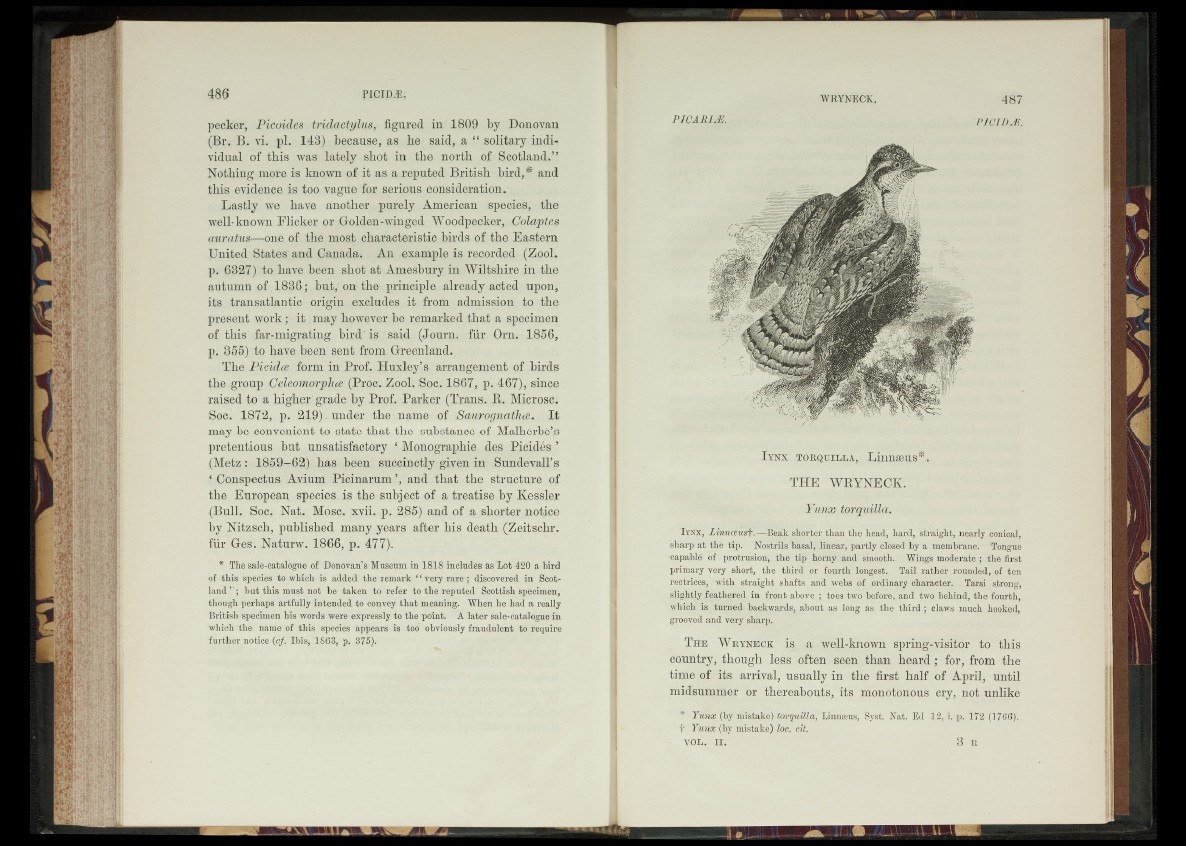
pecker, Picoides tridactylus, figured in 1809 by Donovan
(Br. B. vi. pi. 148) because, as be said, a “ solitary individual
of this was lately shot in the north of Scotland.”
Nothing more is known of it as a reputed British bird,* and
this evidence is too vague for serious consideration.
Lastly we have another purely American species, the
well-known Flicker or Golden-winged Woodpecker, Colaptes
auratus—one of the most characteristic birds of the Eastern
United States and Canada. An example is recorded (Zool.
p. 6827) to have been shot at Amesbury in Wiltshire in the
autumn of 1836; but, on the principle already acted upon,
its transatlantic origin excludes it from admission to the
present work; it may however be remarked that a specimen
of this far-migrating bird' is said (Journ. fur Orn. 1856,
p. 355) to have been sent from Greenland.
The Picidce form in Prof. Huxley’s arrangement of birds
the group Celeomorplue (Proc. Zool. Soc. 1867, p. 467), since
raised to a higher grade by Prof. Parker (Trans.. R. Microsc.
Soc. 1872, p. 219).under the name of Saurognathce. It
may be convenient to state that the substance of Malherbe’s
pretentious but unsatisfactory £ Monographie des Picides ’
(Metz : 1859—62) has been succinctly given in Sundevall’s
i Conspectus Avium Picinarum ’, and that the structure of
the European species is the subject of a treatise by Kessler
(Bull. Soc. Nat. Mosc. xvii. p. 285) and of a shorter notice
by Nitzsch, published many years after his death (Zeitschr.
fur Ges. Naturw. 1866, p. 477).
* The sale-catalogue of Donovan’s Museum in 1818 includes as Lot 420 a bird
of this species to which is added the remark ‘ ‘ very rare ; discovered in Scotland’';
but this must not be taken to refer to the reputed Scottish specimen,
though perhaps artfully intended to convey that meaning. When he had a really
British specimen his words were expressly to the point. A later sale-catalogue in
which the name of this species appears is tod obviously fraudulent to require
further notice (cf. Ibis, 1863, p. 375).
P ICARUS. PICIDAi.
Iynx torquilla, Linnaeus*.
THE WRYNECK.
Yunx torquilla.
Iynx, Linnceusf.—Beak shorter than the head, hard, straight, nearly conical,
sharp at the tip. Nostrils basal, linear, partly closed by a membrane. Tongue
capable of protrusion, the tip horny and smooth. Wings moderate ; the first
primary very short, the third or fourth longest. Tail rather rounded, of ten
rectrices, with straight shafts and webs of ordinary character. Tarsi strong,
slightly feathered in front above ; toes two before, and two behind, the fourth,
which is turned backwards, about as long as the third ; claws much hooked,
grooved and very sharp.
T h e W r y n e c k is a well-known spring-visitor to this
country, though less often seen than heard; for, from the
time of its arrival, usually in the first half of April, until
midsummer or thereabouts, its monotonous cry, not unlike
* Yunx (by mistake) torquilla, Linnaeus, Syst. Nat. Ed 12, i. p. 172 (1766).
t Yunx (by mistake) loc. cit.
VOL. II. 3 R